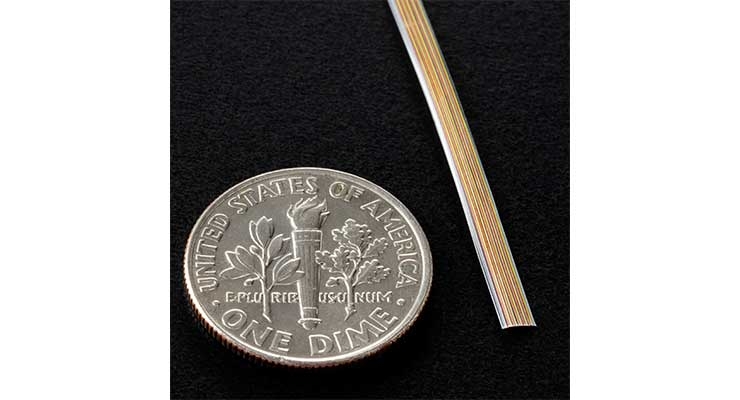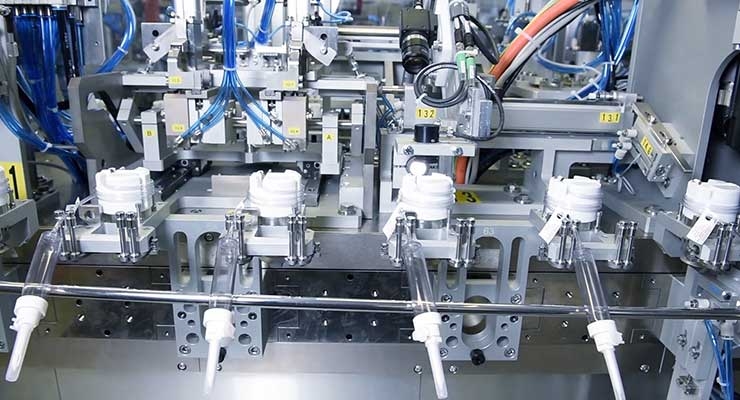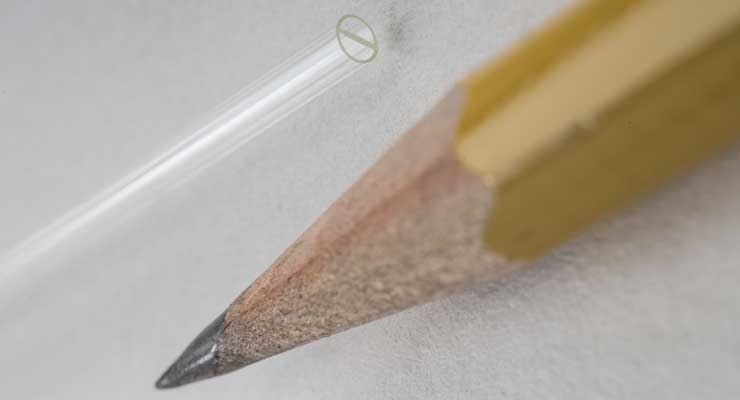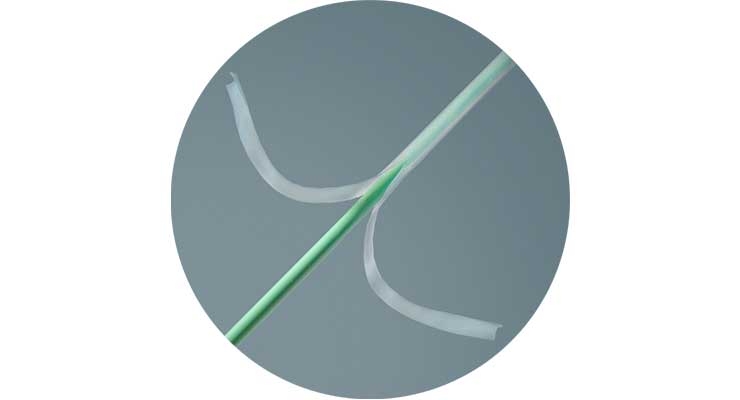Mark Crawford, Contributing Writer04.01.20
Medical tubing is a growing market, with a steadily expanding number of suppliers that extrude commodity resins. Medical device manufacturers (MDMs) are always looking for ways to improve the capabilities of their tubing, which helps differentiate them in the marketplace. In response, a growing niche market has emerged that focuses primarily on specialty tubing, materials, and proprietary compounds for highly specific applications.
Medical tubing is in high demand, especially as medical devices become smaller and more complex. According to Market Watch, the global medical tubing market is valued at $8.4 billion in 2020 and expected to reach $13.8 billion by the end of 2026, growing at a compound annual growth rate of 7.2 percent during 2021-2026.1
“The medical tubing market continues to be a dynamic one, primarily because of the variety of pressures on companies within this space to provide cost-effective, high-quality products in shorter time scales,” said Joe Rowan, president and CEO of USA and Europe for Junkosha, a provider of peelable heat shrink tubing technologies. “This is mainly driven by the global healthcare market, which continues to demand innovative products and solutions that push the boundaries of what is possible, at a price point that is highly competitive.”
As strong as the medical tubing market is, some slowing down is being seen as MDMs and their contract manufacturers (CMs) struggle to apply updated regulatory requirements to new and existing products. Regulatory bodies and new rules, such as the EU Medical Device Regulation and Chinese FDA, for example, are demanding increased risk mitigation for medical devices and their components—a compliance challenge many MDMs expect their supply chain partners, including tubing manufacturers, to help them navigate.
Technology Trends
Technology advances in medical tubing are driven by the demand for smaller wall thicknesses, smaller interior and outside diameters, and tighter tolerances, all while maintaining or enhancing performance. End users are insisting on smaller and more complex medical devices for an increasing number of innovative applications and procedures, many of which require some type of customized tubing.
“This trend toward miniaturization is in response to minimally invasive procedures in areas we did not have devices small enough to access 15 to 20 years ago,” said Charles Golub, market development manager for Saint-Gobain Life Sciences, a Northborough, Mass.-based provider of medical tubing. “As a result, the ability to miniaturize medical technology will drive growth in treatments, such as peripheral artery disease and neurology, for years to come.”
Demand for silicone is steadily increasing because of its biocompatibility—a property critical for regulatory approval. Smaller and more complex silicone extrusions are also in high demand as devices become smarter and procedures less invasive. “We are seeing growth in the partnerships between the engineering teams of device manufacturers and their suppliers to accelerate the device design and innovation process,” said Dan Sanchez, product manager for Trelleborg Healthcare and Medical, a Schaumburg, Ill.-based provider of silicone extrusions for the medical and pharmaceutical markets. “The most successful medical device OEMs are collaborating with innovative manufacturers, early in the concept stage, to move the latest technologies forward.”
In the world of neurovascular procedures, clinicians want devices that allow them to perform complex procedures more efficiently, reduce costs, and also relieve surgeon fatigue and improve patient outcomes. Procedures such as delivering stents, coils, and even signals/therapy via catheters are becoming more common.
Every OEM wants to beat the competition, so tubing suppliers are seeing more designs that call for increased functionality, thinner walls, kink resistance, more lumens, less friction, and even the ability to handle hazardous chemicals. For example, one way to add value is the integration of wire conductors into the walls of the tubing, which “saves customers from having to run wires down a tube or lumen, and allows more space for other components within the tubing, which results in more functionality in the same tubular cross-section,” said Derek Wilkins, regional sales manager for New England Tubing Technologies, a Lisbon, N.H.-based manufacturer of custom tubing.
What OEMs Want
MDMs’ demands for tubing include increased functionality and performance, including more challenging geometries, tighter tolerances, and reduced component size. They especially want superior biocompatibility, which is why they often select silicone and modify it with other materials to improve mechanical performance. Tubing suppliers that can customize tubing materials and shapes to meet specific medical device requirements are always in high demand.
Of course, the number-one priority for MDMs is finding a tubing partner that delivers consistent and reliable quality. As designs become more challenging, and technologies continuously advance, MDMs also want additional services and support, especially regarding customized materials as well as regulatory support and guidance as new regulations come into play.
In short, OEMs are looking for full-service providers to share the burden of medical device design, development, and production.
“Companies that can assist with tubing design and material selection, and provide secondary process operations beyond the tubing extrusion process, are in high demand because they can fill an OEM’s in-house extrusion gaps,” said Eric Ernst, international territory manager for Fluortek, an Easton, Pa.-based provider of precision fluoropolymer melt and paste extrusions.
“The fact that many device manufacturers have specialized in key areas and cut back their R&D pushes more demand for expertise from their suppliers,” added Golub. “Additionally, the ability to offer testing that helps solve a customer’s problems is more common. Having an applications or R&D department to help service customers used to be an added benefit—now it is a ‘must-have’ to effectively compete in the marketplace.”
New Technology Advancements
The steady trend toward miniaturization and minimally invasive procedures continues to shape medical device design. End users are demanding catheters that can access hard-to-reach places in the human body, reducing the risk of damaging sensitive or delicate organs or tissues. Applications include neurovascular delivery of stroke or aneurysm therapies and the transmission of signals/energy that support therapies such as neuromodulation or neurostimulation (for example, treatment for Parkinson’s disease).
Junkosha’s 2.5:1 peelable heat shrink tubing (PHST) provides catheter manufacturers with one of the highest shrink ratios currently possible in peelable fluorinated ethylene propylene (FEP). Its “take up” (the ability to absorb tolerances) allows the use of cost-effective, lower tolerance, baseline materials in the manufacturing process and enables the reflow of these materials easily into a single smooth construct in one step. This reduces total cost of ownership for the catheter manufacturer, increasing the cost margin per construct.
Applications for this high-ratio PHST technology include neurovascular catheters that have tapered diameters for the floppy distal segments, and proximal sections with larger diameters for pushable support. Because these catheters are mostly braid reinforced proximally and coil reinforced distally, there is a need for a peelable heat shrink solution that can accommodate in a single step the compression required to provide significant bond strength of the materials.
A further trend is the need for increasingly sophisticated “active” catheters that can send diagnostic signals into the body or provide therapy. Ultra-fine cables carry multiple signals through a very small shaft, enabling a new generation of small, flexible, and intelligent catheters that provide increased functionality and capture data from formerly inaccessible areas of the body.
For example, the Multi-Filar active catheter solution from Junkosha is manufactured using precision-engineered polytetrafluoroethylene (PTFE) lamination technology. Single-strand configurations are joined into a multi-filar assembly that can be utilized in electrophysiology catheters for applying pacing and recording protocols from inside the heart, ablation and balloon ablation catheters for atrial fibrillation, as well as cardiac mapping. The multi-filar technique allows for easier assembly of the signal or power wires into the final medical device—cables have a capacity of up to 60 lines, depending on AWG (American wire gauge) size or pitch, and provide multiple signals through the ultra-small shaft.
New England Tubing Technologies’ eTubing products incorporate customized wires or cables within the wall of the tubing itself, saving valuable space within the tube and enabling analog and digital transmission of electrical signals for sensor capabilities, powering for devices, and temperature/oxygen monitoring features. Ideal applications include handheld electrosurgical devices, cauterization, ultrasonic devices, monitoring devices, and endoscopes.
Trelleborg’s GeoTran technology enables MDMs to design more complex devices with fewer parts by replacing multiple extrusion and assembly components with a single extrusion. Movable die and mandrels allow the production of tubes with transitional geometry—for example, tubes with variable outer diameters and constant or variable inner diameters. This capability expands design possibilities—for example, silicone balloons are common in many medical devices. A preformed balloon segment is typically bonded to a catheter shaft at a position where a small opening allows inflation by saline or air. GeoTran balloons are formed in a single extrusion step as part of the catheter shaft, eliminating the costs associated with secondary operations and inspections. “Ultimately, GeoTran technology leads to higher-quality devices, with fewer failure points and better patient outcomes,” said Sanchez.
There is also an increasing trend toward the 3D printing of flexible materials. Digital light processing (DLP) and ink-drop printing methods have been enabled by new chemistry formulations focused on low-viscosity materials. These new methods enable better resolution and the use of elastomers with improved properties. “As a result, there is potential for these printing technologies to be readily adopted for low-volume, intricate multi-lumen or multi-component parts that otherwise would not have been worth the investment in tooling,” said Golub. “This could, in turn, push the boundaries for complex, higher resolution, short length tubing, as well as multi-materials systems where there is high value in complex components.”
New Material Choices
Most of thermoplastics used in endovascular-related devices are from the nylon, polyether block amide (PEBA), and polyurethane families. Certain grades of these base polymers are partially compatible in that they have similar viscosities and melt temperatures. As a result, they can be compounded together at different ratios to form miscible polymer blends; they can also be co-extruded together to form multi-layer tubing with an outer layer and an inner layer of two different partially compatible polymers. “Polymer blends and multi-layer-extrusion technologies can be used to optimize device performance properties such as strength, flexibility, kink resistance, bondability, burst performance, and trackability for a given application,” said Steve Maxson, vice president of sales for Spectrum Plastics Group, an Alpharetta, Ga.-based medical device contract manufacturer, including extruded tubing.
An example of how these partially compatible polymers can be used together is the dual-layer co-extrusion of high-pressure tubing (>600 psi) with a thin nylon inner layer and a flexible polyurethane outer layer for the intravenous injection of contrast media within the vascular system for angiography. “While a bare nylon tube would have a high-pressure burst rating due to its high modulus, it would be too stiff and more prone to kinking,” said Maxson. “To combat the kink propensity, a lower-modulus flexible polyurethane outer protective layer is used to resist kinking and to provide greater flexibility of the infusion line.”
Lubricity is equally important for catheter tubing, which can be enhanced by specialty coatings bonded to the surface of the tubing. In catheter-based cardiovascular or neurovascular procedures, there are often many twists and turns on the route to the targeted anatomy, so coatings need to be slippery as well as durable. Biocoat, a Horsham, Pa.-based provider of hydrophilic coatings for medical devices, has developed a coating called Hydak that demonstrates durability and lubricity that matches or exceeds other hydrophilic coatings, as well as superior bonding with low particulate counts. In addition, this material is fully biocompatible, made from a compound that already exists in the human body: hyaluronic acid (HA)—a naturally occurring polysaccharide.
OEMs are often unaware of how the formulation of a customized material can solve their technical challenges with medical device design, such as chemical resistance, shelf life, friction, and other general physical properties. For example, Saint-Gobain’s Tygon LCF is a custom formulation with a distinct cost/benefit advantage over other low coefficient of friction materials, such as fluoropolymers. LCF is ideal for endoscopy sheaths, soft-touch components for gentle skin contact, and multi-layered systems where the ability to slide components past each other is required. “Additionally, unlike PTFE, the material can be e-beam or gamma sterilized and bonds well to most materials,” said Golub.
Creating tubing for the medical industry comes with increasing regulatory and process validation requirements. OEMs are looking for materials that meet these requirements and provide more flexibility in tubing sizes and dimensional tolerances. “There are also expectations that plastic compounds have consistent filler dispersion, melting characteristics, and mechanical properties,” said Ernst. “Screw design and compound process engineering also become critical components of material blending that result in consistent and efficient processing of quality tubing and faster entry to market for customers.”
Breakthrough Advances
Major advancements in data collection, in-line process and product monitoring methods, and quality inspection continue to be announced. For example, Freudenberg Medical, a Carpinteria, Calif.-based medical device manufacturer, recently announced its Helix iMC system for the inline measurement of inner diameters for silicone tubes. The system uses sensor technology that continuously measures the inner geometry of extruded products such as single- or multi-lumen interior diameter, wall thickness, or concentricity as an inline process. “Until now, it was not possible to measure the interior diameter of silicone tubing without making manual cuts at various cross sections, usually as an off-line process,” said Max Kley, CEO of Freudenberg Medical. “With this system, MDMs can monitor data continuously across a complete production run without interruption and sample cuts, reducing validation time and saving money.”2
Computer-aided engineering (CAE)—including finite element analysis (FEA), computational fluid dynamics (CFD), and multibody dynamics (MBD)—is increasingly used to model end-use tubing applications. “As the knowledge of chemical and physical interactions grows, the ability to model a tube from pellets, through extrusion and cooling, and then through sterilization and end use, is becoming more of a reality,” said Golub.
Trelleborg is working on several technologies, including advanced kink-resistant tubing. Trelleborg engineers have developed a process for applying reinforcements within a silicone tube wall, which significantly improves the tube’s resistance to kinking; other R&D efforts include incorporating active pharmaceutical ingredients (APIs) into silicone tubing. Silicone composition can hold, and later elute, drugs for localized consistent delivery. Elution rates can be controlled for different applications. “Such APIs include antimicrobials, antibacterials, hormones, and steroids,” said Sanchez. “In addition, we are continually looking to increase our quality, decrease the size of our extrusions, and solve unique challenges for our customers.”
Freudenberg Medical has also introduced an innovative twisted lumen tubing called HelixTwist. This multi-lumen silicone tubing technology prevents lumen kinks by providing an equal balance of stress across the inner and outer lumens as the tube bends. This tubing is optimal for pacemakers, breathing tubes, neurostimulation, and other applications that require navigation through challenging pathways within the human body.3
In R&D news, Fraunhofer Institute for Digital Medicine in Bremen, Germany, is developing an “intelligent catheter navigation” method that uses a catheter equipped with a special optical fiber containing tiny mirrors. When light passes through the fiber, the mirrors reflect a portion of the light. Whenever the fiber bends, the reflected light changes color. Sensors then measure the change in color, which can indicate intensity and direction of the curvature and path of navigation during endovascular procedures. This eliminates the need for X-rays for guidance, thereby reducing radiation exposure for patients and physicians.4
Moving Forward
Perhaps the biggest challenge for a tubing manufacturer is understanding how to push the limits of its equipment to meet the performance parameters of the material. “For example, if a product requires very thin walls and the materials chosen cannot be processed at thin-walled tolerances, it is critical to understand why—is [it] truly a limit in the materials, or can the equipment be modified to overcome these material shortcomings?” said Golub.
Tubing manufacturers often play a key role in designing a successful medical device. They use their tribal knowledge to develop custom equipment and innovative manufacturing processes to meet specific demands—this includes knowing how far they can push material processes and equipment (or design their own proprietary methods) to keep pace with the rapid advances in the tubing sector.
Medical device designs will continue to be more complex and multifunctional—for example, mapping catheters, which are used during cardiac and electrophysiological therapies, help physicians discover and evaluate the electroanatomic layout of the heart and surrounding area—something that seemed impossible a few years ago.
As MDMs continue to push the limits of design, they increasingly depend on the know-how and technical expertise of their contract manufacturers to help them deliver the best possible product—often coming up with the critical design or manufacturing ideas that turn an impossible design into a productive device that saves lives.
“OEMs are always looking for improved performance and for suppliers that can provide additional services to get them closer to a finished device,” said Wilkins. “They are also looking to partner with suppliers that can provide consistent and reliable quality, as well as documented validation of process qualifications and components.”
For example, customers often request tubing flexibility but also need column strength for insertion. “In general, qualities like flexibility and column strength are opposite of one another, so we work with customers to find a balance between all the qualities and features that they are looking for,” added Wilkins. “Getting our team involved as early as possible in the design phase is hugely important for meeting MDM performance specifications with a design that is also manufacturable.”
References
Mark Crawford is a full-time freelance business and marketing/communications writer based in Madison, Wis. His clients range from startups to global manufacturing leaders. He also writes a variety of feature articles for regional and national publications and is the author of five books.
Medical tubing is in high demand, especially as medical devices become smaller and more complex. According to Market Watch, the global medical tubing market is valued at $8.4 billion in 2020 and expected to reach $13.8 billion by the end of 2026, growing at a compound annual growth rate of 7.2 percent during 2021-2026.1
“The medical tubing market continues to be a dynamic one, primarily because of the variety of pressures on companies within this space to provide cost-effective, high-quality products in shorter time scales,” said Joe Rowan, president and CEO of USA and Europe for Junkosha, a provider of peelable heat shrink tubing technologies. “This is mainly driven by the global healthcare market, which continues to demand innovative products and solutions that push the boundaries of what is possible, at a price point that is highly competitive.”
As strong as the medical tubing market is, some slowing down is being seen as MDMs and their contract manufacturers (CMs) struggle to apply updated regulatory requirements to new and existing products. Regulatory bodies and new rules, such as the EU Medical Device Regulation and Chinese FDA, for example, are demanding increased risk mitigation for medical devices and their components—a compliance challenge many MDMs expect their supply chain partners, including tubing manufacturers, to help them navigate.
Technology Trends
Technology advances in medical tubing are driven by the demand for smaller wall thicknesses, smaller interior and outside diameters, and tighter tolerances, all while maintaining or enhancing performance. End users are insisting on smaller and more complex medical devices for an increasing number of innovative applications and procedures, many of which require some type of customized tubing.
“This trend toward miniaturization is in response to minimally invasive procedures in areas we did not have devices small enough to access 15 to 20 years ago,” said Charles Golub, market development manager for Saint-Gobain Life Sciences, a Northborough, Mass.-based provider of medical tubing. “As a result, the ability to miniaturize medical technology will drive growth in treatments, such as peripheral artery disease and neurology, for years to come.”
Demand for silicone is steadily increasing because of its biocompatibility—a property critical for regulatory approval. Smaller and more complex silicone extrusions are also in high demand as devices become smarter and procedures less invasive. “We are seeing growth in the partnerships between the engineering teams of device manufacturers and their suppliers to accelerate the device design and innovation process,” said Dan Sanchez, product manager for Trelleborg Healthcare and Medical, a Schaumburg, Ill.-based provider of silicone extrusions for the medical and pharmaceutical markets. “The most successful medical device OEMs are collaborating with innovative manufacturers, early in the concept stage, to move the latest technologies forward.”
In the world of neurovascular procedures, clinicians want devices that allow them to perform complex procedures more efficiently, reduce costs, and also relieve surgeon fatigue and improve patient outcomes. Procedures such as delivering stents, coils, and even signals/therapy via catheters are becoming more common.
Every OEM wants to beat the competition, so tubing suppliers are seeing more designs that call for increased functionality, thinner walls, kink resistance, more lumens, less friction, and even the ability to handle hazardous chemicals. For example, one way to add value is the integration of wire conductors into the walls of the tubing, which “saves customers from having to run wires down a tube or lumen, and allows more space for other components within the tubing, which results in more functionality in the same tubular cross-section,” said Derek Wilkins, regional sales manager for New England Tubing Technologies, a Lisbon, N.H.-based manufacturer of custom tubing.
What OEMs Want
MDMs’ demands for tubing include increased functionality and performance, including more challenging geometries, tighter tolerances, and reduced component size. They especially want superior biocompatibility, which is why they often select silicone and modify it with other materials to improve mechanical performance. Tubing suppliers that can customize tubing materials and shapes to meet specific medical device requirements are always in high demand.
Of course, the number-one priority for MDMs is finding a tubing partner that delivers consistent and reliable quality. As designs become more challenging, and technologies continuously advance, MDMs also want additional services and support, especially regarding customized materials as well as regulatory support and guidance as new regulations come into play.
In short, OEMs are looking for full-service providers to share the burden of medical device design, development, and production.
“Companies that can assist with tubing design and material selection, and provide secondary process operations beyond the tubing extrusion process, are in high demand because they can fill an OEM’s in-house extrusion gaps,” said Eric Ernst, international territory manager for Fluortek, an Easton, Pa.-based provider of precision fluoropolymer melt and paste extrusions.
“The fact that many device manufacturers have specialized in key areas and cut back their R&D pushes more demand for expertise from their suppliers,” added Golub. “Additionally, the ability to offer testing that helps solve a customer’s problems is more common. Having an applications or R&D department to help service customers used to be an added benefit—now it is a ‘must-have’ to effectively compete in the marketplace.”
New Technology Advancements
The steady trend toward miniaturization and minimally invasive procedures continues to shape medical device design. End users are demanding catheters that can access hard-to-reach places in the human body, reducing the risk of damaging sensitive or delicate organs or tissues. Applications include neurovascular delivery of stroke or aneurysm therapies and the transmission of signals/energy that support therapies such as neuromodulation or neurostimulation (for example, treatment for Parkinson’s disease).
Junkosha’s 2.5:1 peelable heat shrink tubing (PHST) provides catheter manufacturers with one of the highest shrink ratios currently possible in peelable fluorinated ethylene propylene (FEP). Its “take up” (the ability to absorb tolerances) allows the use of cost-effective, lower tolerance, baseline materials in the manufacturing process and enables the reflow of these materials easily into a single smooth construct in one step. This reduces total cost of ownership for the catheter manufacturer, increasing the cost margin per construct.
Applications for this high-ratio PHST technology include neurovascular catheters that have tapered diameters for the floppy distal segments, and proximal sections with larger diameters for pushable support. Because these catheters are mostly braid reinforced proximally and coil reinforced distally, there is a need for a peelable heat shrink solution that can accommodate in a single step the compression required to provide significant bond strength of the materials.
A further trend is the need for increasingly sophisticated “active” catheters that can send diagnostic signals into the body or provide therapy. Ultra-fine cables carry multiple signals through a very small shaft, enabling a new generation of small, flexible, and intelligent catheters that provide increased functionality and capture data from formerly inaccessible areas of the body.
For example, the Multi-Filar active catheter solution from Junkosha is manufactured using precision-engineered polytetrafluoroethylene (PTFE) lamination technology. Single-strand configurations are joined into a multi-filar assembly that can be utilized in electrophysiology catheters for applying pacing and recording protocols from inside the heart, ablation and balloon ablation catheters for atrial fibrillation, as well as cardiac mapping. The multi-filar technique allows for easier assembly of the signal or power wires into the final medical device—cables have a capacity of up to 60 lines, depending on AWG (American wire gauge) size or pitch, and provide multiple signals through the ultra-small shaft.
New England Tubing Technologies’ eTubing products incorporate customized wires or cables within the wall of the tubing itself, saving valuable space within the tube and enabling analog and digital transmission of electrical signals for sensor capabilities, powering for devices, and temperature/oxygen monitoring features. Ideal applications include handheld electrosurgical devices, cauterization, ultrasonic devices, monitoring devices, and endoscopes.
Trelleborg’s GeoTran technology enables MDMs to design more complex devices with fewer parts by replacing multiple extrusion and assembly components with a single extrusion. Movable die and mandrels allow the production of tubes with transitional geometry—for example, tubes with variable outer diameters and constant or variable inner diameters. This capability expands design possibilities—for example, silicone balloons are common in many medical devices. A preformed balloon segment is typically bonded to a catheter shaft at a position where a small opening allows inflation by saline or air. GeoTran balloons are formed in a single extrusion step as part of the catheter shaft, eliminating the costs associated with secondary operations and inspections. “Ultimately, GeoTran technology leads to higher-quality devices, with fewer failure points and better patient outcomes,” said Sanchez.
There is also an increasing trend toward the 3D printing of flexible materials. Digital light processing (DLP) and ink-drop printing methods have been enabled by new chemistry formulations focused on low-viscosity materials. These new methods enable better resolution and the use of elastomers with improved properties. “As a result, there is potential for these printing technologies to be readily adopted for low-volume, intricate multi-lumen or multi-component parts that otherwise would not have been worth the investment in tooling,” said Golub. “This could, in turn, push the boundaries for complex, higher resolution, short length tubing, as well as multi-materials systems where there is high value in complex components.”
New Material Choices
Most of thermoplastics used in endovascular-related devices are from the nylon, polyether block amide (PEBA), and polyurethane families. Certain grades of these base polymers are partially compatible in that they have similar viscosities and melt temperatures. As a result, they can be compounded together at different ratios to form miscible polymer blends; they can also be co-extruded together to form multi-layer tubing with an outer layer and an inner layer of two different partially compatible polymers. “Polymer blends and multi-layer-extrusion technologies can be used to optimize device performance properties such as strength, flexibility, kink resistance, bondability, burst performance, and trackability for a given application,” said Steve Maxson, vice president of sales for Spectrum Plastics Group, an Alpharetta, Ga.-based medical device contract manufacturer, including extruded tubing.
An example of how these partially compatible polymers can be used together is the dual-layer co-extrusion of high-pressure tubing (>600 psi) with a thin nylon inner layer and a flexible polyurethane outer layer for the intravenous injection of contrast media within the vascular system for angiography. “While a bare nylon tube would have a high-pressure burst rating due to its high modulus, it would be too stiff and more prone to kinking,” said Maxson. “To combat the kink propensity, a lower-modulus flexible polyurethane outer protective layer is used to resist kinking and to provide greater flexibility of the infusion line.”
Lubricity is equally important for catheter tubing, which can be enhanced by specialty coatings bonded to the surface of the tubing. In catheter-based cardiovascular or neurovascular procedures, there are often many twists and turns on the route to the targeted anatomy, so coatings need to be slippery as well as durable. Biocoat, a Horsham, Pa.-based provider of hydrophilic coatings for medical devices, has developed a coating called Hydak that demonstrates durability and lubricity that matches or exceeds other hydrophilic coatings, as well as superior bonding with low particulate counts. In addition, this material is fully biocompatible, made from a compound that already exists in the human body: hyaluronic acid (HA)—a naturally occurring polysaccharide.
OEMs are often unaware of how the formulation of a customized material can solve their technical challenges with medical device design, such as chemical resistance, shelf life, friction, and other general physical properties. For example, Saint-Gobain’s Tygon LCF is a custom formulation with a distinct cost/benefit advantage over other low coefficient of friction materials, such as fluoropolymers. LCF is ideal for endoscopy sheaths, soft-touch components for gentle skin contact, and multi-layered systems where the ability to slide components past each other is required. “Additionally, unlike PTFE, the material can be e-beam or gamma sterilized and bonds well to most materials,” said Golub.
Creating tubing for the medical industry comes with increasing regulatory and process validation requirements. OEMs are looking for materials that meet these requirements and provide more flexibility in tubing sizes and dimensional tolerances. “There are also expectations that plastic compounds have consistent filler dispersion, melting characteristics, and mechanical properties,” said Ernst. “Screw design and compound process engineering also become critical components of material blending that result in consistent and efficient processing of quality tubing and faster entry to market for customers.”
Breakthrough Advances
Major advancements in data collection, in-line process and product monitoring methods, and quality inspection continue to be announced. For example, Freudenberg Medical, a Carpinteria, Calif.-based medical device manufacturer, recently announced its Helix iMC system for the inline measurement of inner diameters for silicone tubes. The system uses sensor technology that continuously measures the inner geometry of extruded products such as single- or multi-lumen interior diameter, wall thickness, or concentricity as an inline process. “Until now, it was not possible to measure the interior diameter of silicone tubing without making manual cuts at various cross sections, usually as an off-line process,” said Max Kley, CEO of Freudenberg Medical. “With this system, MDMs can monitor data continuously across a complete production run without interruption and sample cuts, reducing validation time and saving money.”2
Computer-aided engineering (CAE)—including finite element analysis (FEA), computational fluid dynamics (CFD), and multibody dynamics (MBD)—is increasingly used to model end-use tubing applications. “As the knowledge of chemical and physical interactions grows, the ability to model a tube from pellets, through extrusion and cooling, and then through sterilization and end use, is becoming more of a reality,” said Golub.
Trelleborg is working on several technologies, including advanced kink-resistant tubing. Trelleborg engineers have developed a process for applying reinforcements within a silicone tube wall, which significantly improves the tube’s resistance to kinking; other R&D efforts include incorporating active pharmaceutical ingredients (APIs) into silicone tubing. Silicone composition can hold, and later elute, drugs for localized consistent delivery. Elution rates can be controlled for different applications. “Such APIs include antimicrobials, antibacterials, hormones, and steroids,” said Sanchez. “In addition, we are continually looking to increase our quality, decrease the size of our extrusions, and solve unique challenges for our customers.”
Freudenberg Medical has also introduced an innovative twisted lumen tubing called HelixTwist. This multi-lumen silicone tubing technology prevents lumen kinks by providing an equal balance of stress across the inner and outer lumens as the tube bends. This tubing is optimal for pacemakers, breathing tubes, neurostimulation, and other applications that require navigation through challenging pathways within the human body.3
In R&D news, Fraunhofer Institute for Digital Medicine in Bremen, Germany, is developing an “intelligent catheter navigation” method that uses a catheter equipped with a special optical fiber containing tiny mirrors. When light passes through the fiber, the mirrors reflect a portion of the light. Whenever the fiber bends, the reflected light changes color. Sensors then measure the change in color, which can indicate intensity and direction of the curvature and path of navigation during endovascular procedures. This eliminates the need for X-rays for guidance, thereby reducing radiation exposure for patients and physicians.4
Moving Forward
Perhaps the biggest challenge for a tubing manufacturer is understanding how to push the limits of its equipment to meet the performance parameters of the material. “For example, if a product requires very thin walls and the materials chosen cannot be processed at thin-walled tolerances, it is critical to understand why—is [it] truly a limit in the materials, or can the equipment be modified to overcome these material shortcomings?” said Golub.
Tubing manufacturers often play a key role in designing a successful medical device. They use their tribal knowledge to develop custom equipment and innovative manufacturing processes to meet specific demands—this includes knowing how far they can push material processes and equipment (or design their own proprietary methods) to keep pace with the rapid advances in the tubing sector.
Medical device designs will continue to be more complex and multifunctional—for example, mapping catheters, which are used during cardiac and electrophysiological therapies, help physicians discover and evaluate the electroanatomic layout of the heart and surrounding area—something that seemed impossible a few years ago.
As MDMs continue to push the limits of design, they increasingly depend on the know-how and technical expertise of their contract manufacturers to help them deliver the best possible product—often coming up with the critical design or manufacturing ideas that turn an impossible design into a productive device that saves lives.
“OEMs are always looking for improved performance and for suppliers that can provide additional services to get them closer to a finished device,” said Wilkins. “They are also looking to partner with suppliers that can provide consistent and reliable quality, as well as documented validation of process qualifications and components.”
For example, customers often request tubing flexibility but also need column strength for insertion. “In general, qualities like flexibility and column strength are opposite of one another, so we work with customers to find a balance between all the qualities and features that they are looking for,” added Wilkins. “Getting our team involved as early as possible in the design phase is hugely important for meeting MDM performance specifications with a design that is also manufacturable.”
References
Mark Crawford is a full-time freelance business and marketing/communications writer based in Madison, Wis. His clients range from startups to global manufacturing leaders. He also writes a variety of feature articles for regional and national publications and is the author of five books.



















